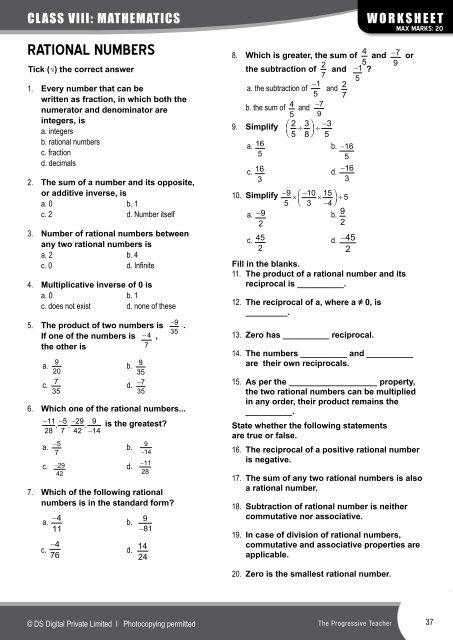The Progressive Teacher Vol 04 Issue 04
This issue of The Progressive Teacher focuses on "New Instructional Tools ". In this edition, articles explore the changes brought by technological advancements in the tools of educational instruction. Enjoy reading!
This issue of The Progressive Teacher focuses on "New Instructional Tools ". In this edition, articles explore the changes brought by technological advancements in the tools of educational instruction. Enjoy reading!
You also want an ePaper? Increase the reach of your titles
YUMPU automatically turns print PDFs into web optimized ePapers that Google loves.
Class VIII: Mathematics<br />
worksheet<br />
Max Marks: 20<br />
Rational numbers<br />
8. Which is greater, the sum of 4 5 and 7<br />
Tick (√) the correct answer<br />
1. Every number that can be<br />
written as fraction, in which both the<br />
numerator and denominator are<br />
integers, is<br />
a. integers<br />
b. rational numbers<br />
c. fraction<br />
d. decimals<br />
2. <strong>The</strong> sum of a number and its opposite,<br />
or additive inverse, is<br />
a. 0 b. 1<br />
c. 2 d. Number itself<br />
3. Number of rational numbers between<br />
any two rational numbers is<br />
a. 2 b. 4<br />
c. 0 d. Infinite<br />
4. Multiplicative inverse of 0 is<br />
a. 0 b. 1<br />
c. does not exist d. none of these<br />
5. <strong>The</strong> product of two numbers is<br />
If one of the numbers is − 4 ,<br />
the other is<br />
7<br />
a.<br />
c.<br />
9<br />
20<br />
7<br />
35<br />
b.<br />
9<br />
35<br />
d.<br />
−7<br />
35<br />
−9<br />
35 .<br />
6. Which one of the rational numbers...<br />
− 11 5 29 9<br />
, − , − , is the greatest?<br />
28 7 42 −14<br />
a.<br />
−5<br />
7<br />
b.<br />
c. − 29<br />
d.<br />
42<br />
9<br />
−14<br />
−11<br />
28<br />
7. Which of the following rational<br />
numbers is in the standard form?<br />
a.<br />
c.<br />
−4<br />
11<br />
−4<br />
76<br />
b.<br />
d.<br />
9<br />
−81<br />
14<br />
24<br />
the subtraction of 2 7 and − 1 ?<br />
5<br />
−1<br />
a. the subtraction of and 2 5 7<br />
b. the sum of 4 5 and −7<br />
9<br />
9. Simplify ⎛2 3⎞<br />
−3<br />
⎜ ÷ ⎟÷<br />
⎝5 8⎠<br />
5<br />
a. 16 b. −16<br />
5<br />
5<br />
c. 16 3<br />
d.<br />
−16<br />
3<br />
10. Simplify −9 −10 15<br />
×<br />
⎛ ⎞<br />
⎜ × ⎟÷<br />
5<br />
5 ⎝ 3 −4⎠<br />
a. − 9<br />
b. 9<br />
2<br />
2<br />
c. 45<br />
2<br />
d. −45<br />
2<br />
− or<br />
9<br />
Fill in the blanks.<br />
11. <strong>The</strong> product of a rational number and its<br />
reciprocal is __________.<br />
12. <strong>The</strong> reciprocal of a, where a ≠ 0, is<br />
_________.<br />
13. Zero has __________ reciprocal.<br />
14. <strong>The</strong> numbers __________ and __________<br />
are their own reciprocals.<br />
15. As per the ___________________ property,<br />
the two rational numbers can be multiplied<br />
in any order, their product remains the<br />
__________.<br />
State whether the following statements<br />
are true or false.<br />
16. <strong>The</strong> reciprocal of a positive rational number<br />
is negative.<br />
17. <strong>The</strong> sum of any two rational numbers is also<br />
a rational number.<br />
18. Subtraction of rational number is neither<br />
commutative nor associative.<br />
19. In case of division of rational numbers,<br />
commutative and associative properties are<br />
applicable.<br />
20. Zero is the smallest rational number.<br />
© DS Digital Private Limited I Photocopying permitted <strong>The</strong> <strong>Progressive</strong> <strong>Teacher</strong><br />
37


















